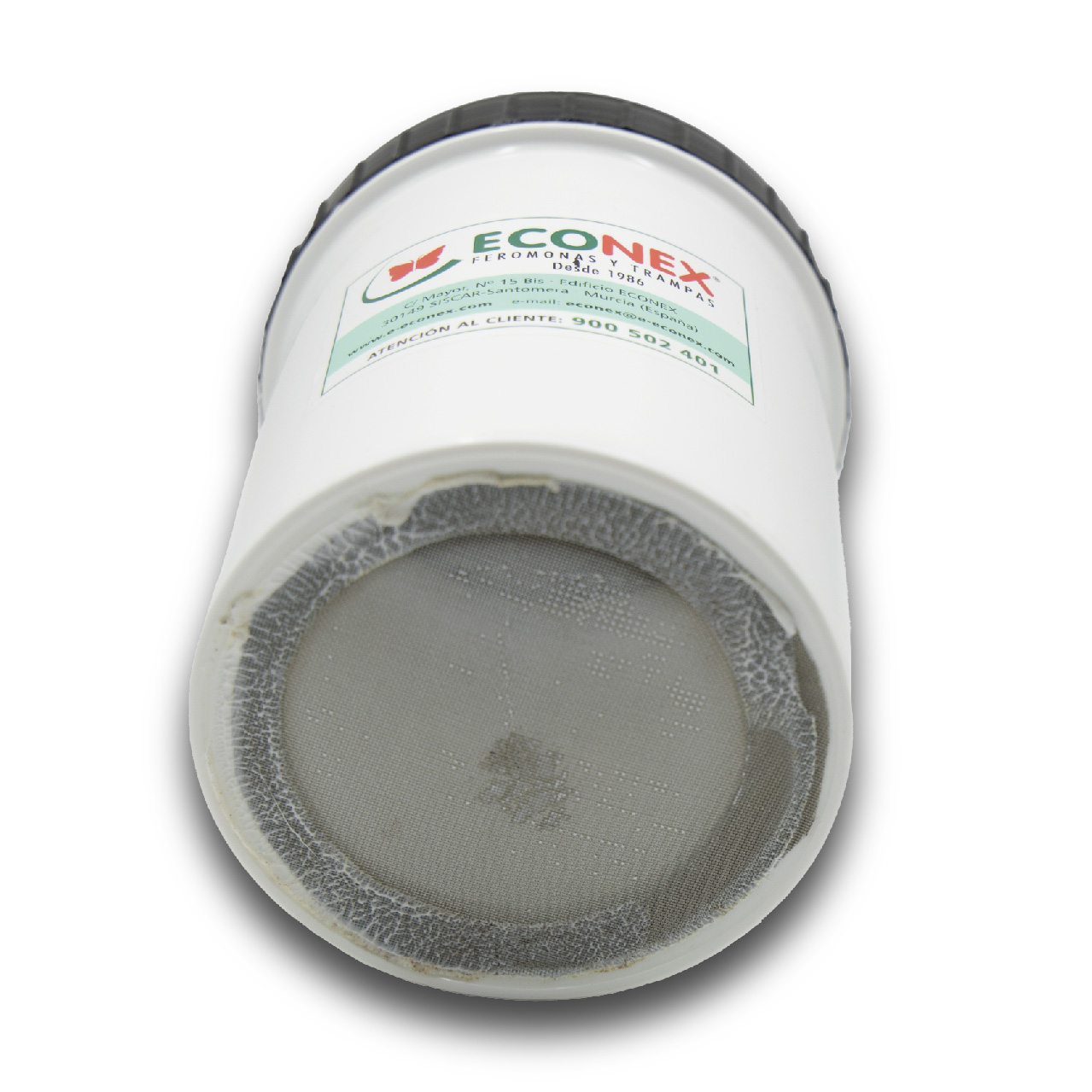Pheromones and traps
A CROSSTRAP® MINI trap and an ECONEX ORTHOTOMICUS EROSUS 60 DAYS (Code: UIPHOVA189) pheromone diffuser, that will hang on the trap using one of the holes on one of the PVC sheets.
ECONEX ORTHOTOMICUS EROSUS 60 DAYS is an aggregation pheromone diffuser that is used to attract male and female Orthotomicus erosus. The diffuser is in a blister pack, with a duration of 60 days in normal field conditions.
It is individually packaged in an aluminium sachet with labelled specifications.
The package includes 1 paperclip hanger to hang the diffuser on the trap. Once taken out of the packaging, the diffuser needs no activation or opening, just placed correctly on the trap.

ECONEX ORTHOTOMICUS EROSUS 60 DAYS
Sexual pheromone diffuser of the species Orthotomicus erosus to attract males, with a duration in field of 60 days.
Code: UIPHOVA189
OMDF register number (Ministry of Agriculture of Spain): 133/2014

For its correct functioning, it is recommended to use it with the CROSSTRAP® MINI trap, a state-of-the-art trap to catch coleopteran insects during flight. This trap has been developed in an R&D project (University of Murcia - ECONEX) with the aim of developing traps and attractants for forest insects.
These traps consist of a polypropylene lid with a central carabiner attached to a stainless-steel spring and two reinforced PVC sheets anchored at the top to the lid by four stainless steel springs that serve as shock absorbers against strong winds, thus helping to avoid damage to the trap.
At the bottom, the reinforced PVC sheets are attached by steel springs to a removable polypropylene funnel with a 30 cm diameter. At the end of the funnel lies the container for holding the captured insects.
The sheets, the funnel and the collector are treated with a slippery product that considerably increases the catches and prevents them from escaping.
The funnel is made of polypropylene, 30 cm in diameter, and consists of two equal halves that can be easily assembled.
The trap can be operational for up to 10 years, due to its high-strength construction and components. The unfolded trap measures 33 cm in diameter by 106 cm in height.
The trap can be used with two types of collector: CROSSTRAP® WET COLLECTION CUP (with slider) 1L for wet catches, and CROSSTRAP® DRY COLLECTION CUP (with slider) for dry use or live catches.
.png)
CROSSTRAP® MINI WITH WET COLLECTION CUP (with slider)
Trap for coleopteran insect interception during flight.
Code: UIPFETA226
OMDF register number (Ministry of Agriculture of Spain): 153/2013

.png)
CROSSTRAP® MINI WITH DRY COLLECTION CUP (with slider)
Trap for coleopteran insect interception during flight.
Code: UIPFETA204
OMDF register number (Ministry of Agriculture of Spain): 153/2013

The CROSSTRAP® WET COLLECTION CUP (with slider) 1 L for retaining captured insects is located at the bottom of the funnel. It has a capacity of approximately 1 litre (11 cm diameter x 13.5 cm high).
The CROSSTRAP® DRY COLLECTION CUP (with slider) is designed to hold the captured insects is located at the bottom of the funnel. It has a capacity of approximately 1 litre (11 cm diameter x 13.5 cm high) and is fitted with a stainless-steel mesh at the bottom to allow rainwater to drain away.
Wet catches allow precise identification of the captures. For this purpose, it is recommended to fill the collector with 10 ml of 10 or 20 % diluted propylene glycol or, if necessary, car antifreeze. This liquid serves both as a kill agent and as a preservative, as long as it is not diluted too much by rain, in which case it should be replaced.

CROSSTRAP® WET COLLECTION CUP (with slider) 1 L
Wet catch collector located at the bottom of CROSSTRAP® traps.
Code: UIPFETA311


CROSSTRAP® DRY COLLECTION CUP (with slider)
Trap collector for dry use, or live traps, located at the bottom of the CROSSTRAP® traps.
Code: UIPFETA157


CROSSTRAP® DRY COLLECTION CUP
View from below
Storing the diffusers
The diffusers must be stored in their original packaging in a cool and dry place and separated from food and drinks.
To preserve the diffusers for long periods of time, it is recommended to keep them in the refrigerator at 4 o C in which case they will last for 2 years. Or they can be kept in the freezer at -20 o C for 4 years.
Diffuser packaging
ECONEX ORTHOTOMICUS EROSUS 60 DAYS
Corrugated cardboard box of 600 units (120 packs of 5 units).
Box size: 0.60 x 0.40 x 0.35 m (length x width x height).
Box weight: 11,15 kg.
No. of boxes per pallet: 20
Pallet size: 1.20 x 0.80 x 1.95 m (length x width x height).
Pallet weight: 233 kg.

Pack of 5 units
Includes a product
information leaflet.

Box of 600 units.
(120 packs x 5 units)
Recommended information:
ECONEX CATALOGUE OF PRODUCTS AND SERVICES FOR FOREST PESTS
Catalogue in PDF format with 94 pages. An essential reference book about the biological behaviours of the main forest insect populations.
It also includes solutions from ECONEX to solve the problems caused by these insects through the use of traps and specific attractants.

ECONEX ORTHOTOMICUS EROSUS 60 DAYS LEAFLET
The leaflet can be downloaded in PDF format by clicking on the image.

ECONEX GREEN AREAS LEAFLET
The leaflet can be downloaded in PDF format by clicking on the image.

www.greenareas.e-econex.eu
Specific website for ECONEX solutions for green areas that you can access by clicking on the image.

ECONEX LEARNING CENTER
ECONEX puts at your disposal the first open knowledge center that brings together everything necessary to implement pest biocontrol in your crops. We have developed different types of resources to share with you the knowledge we have acquired during our more than 38 years of experience. Each of them is designed to respond, in the best possible way, to different questions related to pheromones, attractants, repellents and insect traps.
To access ECONEX LEARNING CENTER click on the image.








.png)












